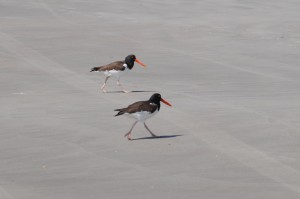Rain, Thunder, Hermit Thrush and Blue-gray Gnatcatcher
Thursday, March 31st, 2011March has come to an end with a full week of cool, rainy weather, several thunderstorms and long periods of heavy rain. The days have been gray, wet and moody – but it’s really good spring weather here – what I think of as a green rain, because you can almost see the green emerging all around, like a watercolor painting.
I also didn’t mind the weather because it made it more appealing to stay curled up inside with a book while getting over a bad cold, and this morning brought yet another cool, deeply cloudy day, with a steady mist of rain.
Lots of birds sang right through the rain all week, and this morning, the first one I heard as I stepped out the door was a Brown Thrasher, followed by the quick little song of a Ruby-crowned Kinglet, then the irrepressible cheery-cheery-cheery-cheery of a Carolina Wren and the elegant, liquid song of a Northern Cardinal. A Louisiana Waterthrush continued to sing all along the creek. Three or four Chipping Sparrows spun their light, thin, lingering trills.
Dogwoods have come into lacey white bloom all through the woods, like white mist, a touch of kindness to these woods that look so ravaged with dead and dying pines and lots of fallen, broken trunks and branches on the ground. It’s been a rough winter – following a rough two or three years of pine beetle damage. Now sweet gums, water oaks, vines and other plants are leafing out and turning green, along with the dogwoods, so it’s beginning to look a little less sad and bedraggled.
A pair of Red-bellied Woodpeckers seems happy enough with one tall, ragged dead pine just inside the woods. They go back and forth from a hole near its broken-off top frequently, so we think they may be nesting there.
A Pileated Woodpecker trumpeted from somewhere in the distance. A Tufted Titmouse sang peter-peter. A Red-bellied Woodpecker gave its lush quuurrrr call.
Cedar Waxwings perched in the still-bare limbs of pecan trees around the front yard, little blobs of crested-gray against a misty gray sky, at least three dozen of them, probably more. Their high, thin calls sounded so shrill and piercing they almost hurt the ears, an unpleasant sound, insistent and sustained, like a high, insect-like whine that seemed unusual. Maybe it’s because there were so many of them calling at once, and all in one place, not flying and passing quickly by.
A Mourning Dove cooed. A couple of Blue Jays creaked out jay-jay! And the slow, sweet, plaintive Come-a-way with me of a White-throated Sparrow rose like a curl of mist from a dense bank of shrubs, the song that seems most in tune with the bittersweet mood of the day, and the season.
A male Eastern Bluebird – and a Carolina Chickadee – both suddenly burst across the yard, both looking as if they had just emerged from the bluebird house, though that’s unlikely. Maybe one just happened to be in the vicinity. I didn’t see for sure. But I wonder what’s happening there, and who is in possession, if either.
Then a Hermit Thrush flew up to a branch with a chrup that I heard before I saw its olive-brown back and rusty-cinnamon tail. It stood with its back to me, looking over its shoulder with a wide eye and then flew down to the ground and somewhere out of sight.
Later – almost noon – the day was still gray and misting rain, and I was working in my office when I heard the emphatic spee-spee-spee! of a Blue-gray Gnatcatcher just outside the windows, the first of the season here around our yard and woods.
